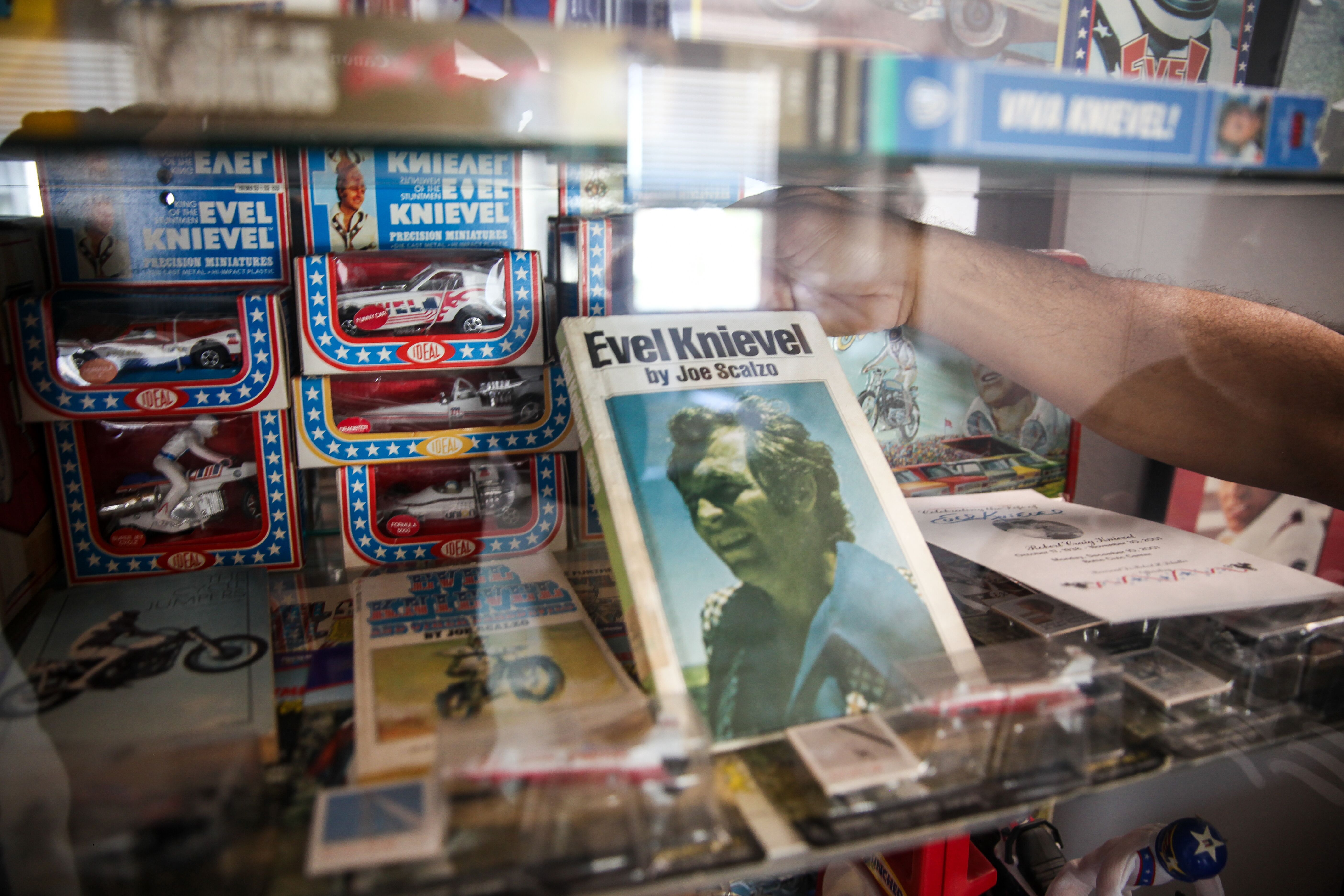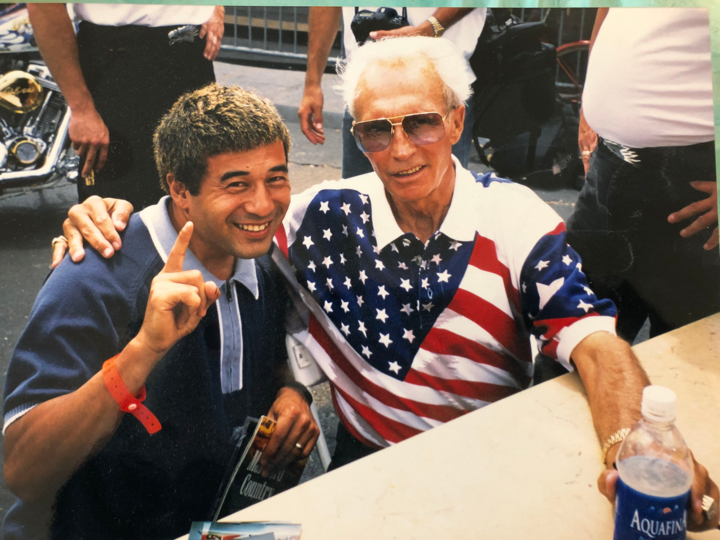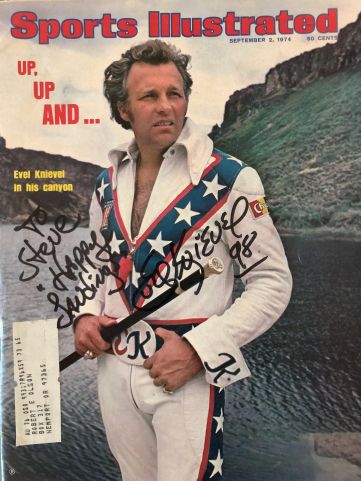Welcome to The Collectors, a series in which we profile the people behind impressive private collections.
As I enter into the home of professional skateboard Steve Caballero, one thing becomes apparent pretty quickly: The guy is an avid collector of things.
There are display cases filled with skateboarding memorabilia and the walls are decorated with paintings, silk screens, original drawings, electric guitars and skateboard decks. One particular wall displays more than 100 original skateboards from the 1970s.
And while I could happily peruse these magnificent collections for hours, I’m here specifically to see Caballero’s prized Evel Knievel toy collection; a nearly complete assemblage of branded puzzles, carded and boxed action figures, play sets and adventure set — it’s a private museum dedicated to highlighting the glory of one of the most iconic motorcycle daredevils of all time.
As Caballero reaches into his glass display case and begins to bring out items to show me, I can’t help but relish in the nostalgia, recognizing some of the pieces in his collection from my own childhood. There is no forgetting the memorable 1970s Evel Knievel Stunt Cycle — a remarkably well-engineered toy with a ramp that you could torque-up with a lever crank before letting the 6 inch action figure on a motorcycle jettison into action. It’s a toy that I distinctly recall scraping my knuckles on the concrete sidewalks while winding the crank as fast as I could to send Evel down our neighborhood cul-de-sac.
“I was so inspired by this single toy,” says Caballero. He has every variation of the Evel Knievel Stunt Cycle in his collection — the original ‘70s launch ramps were manufactured in yellow, red, blue and orange. In the 2000s a reissue included a centennial red-white-blue variety. Reaching deeper into his display case, Caballero pulls out a scaled-down version of the Stunt Cycle that was released only in Japan.
“The action figure, the bike and the energizer are all smaller than the U.S. versions. This was a really cool find,” he enthuses.

For Caballero, who grew up in an era when stars like Bruce Lee, Clint Eastwood and Steve McQueen were action gods of the time, the guy on the motorcycle in the white jumpsuit represented a sort of danger and excitement he craved as a kid.
“I love that I grew up in the ’70s,” says Caballero. “Evel Knievel was an icon who I grew up seeing on TV, in the toy stores and in movies. He made a big impact on my life, my career and my interests.”
At age 10, Caballero would set up bicycle ramps and little garbage cans to jump over outside of his home. And he would soup-up his bicycle with anything he could find to make it look like Knievel’s motorcycle. He would remove closers from screen doors and install them on the frame to look like shocks, put on aftermarket plastic fuel tank and accessories and, of course, clip a playing card to the front fork so that it would sound like a motorcycle when flipped through the bicycle spokes.
“What he always represented to me was a person that overcame fears and a man of his word,” says Caballero. “When he said he was going to do something, he didn’t back out. He also showed me that even though you might be broken and bruised; you could come back and continue pushing the limits of what is possible, assuming your body is still intact. You can go out there and be creative and bring excitement to people in the world.”
In his own career, Caballero was fueled by the same determination and fearless approach as his childhood hero. After a series of successful skateboarding contests, Caballero joined the Powell Peralta Bones Brigade professional skateboarding team in 1979 — a team he still rides for today. He invented a number of skateboarding tricks, including the “Caballerial” (a 360 backside ollie from fakie), won countless competitions on vert ramps and in street contests. Then in 1999, Thrasher magazine named Caballero “Skater of the Century.” And while Caballero earned these accolades on his own merit, he is grateful for the inspiration that Evel Knievel left him with.
After winning X Games Trials in 1998 in St. Petersburg, Florida, Caballero got a chance meet his hero. “I got a phone call from Matt Hoffman [professional BMX rider] who was doing a collaboration bicycle with Evel Knievel,” says Caballero. “Matt told me that Evel was going to be there signing autographs, so I went and met Evel, spoke about a few things. Then he signed my winning skateboard deck and a Sports Illustrated I have with him on the cover.” The signature reads: To Steve, “Happy Landings” Evel Knievel.

Caballero’s collection — made up of more than 120 pieces mostly produced by the now-defunct Ideal Toy Company — is nearly complete: A 1977 CB Van complete with gullwing doors and workable CB messaging system where you can hear Evel talking by pressing a button inside the cab; the Canyon Sky Cycle (Produced from 1974-1977) emulating the one he used in the famous Snake River Canyon stunt; a 1974 Aladdin lunchbox and thermos with Evel Knievel graphics inspired by several of his most famous stunts; even the super rare Strato-cycle that was produced to tie in with the 1977 film Viva Knievel! starring Evel Knievel.
In fact, the only missing piece in his collection is a rare and elusive Evel Knievel Canyon Rig — complete with pickup truck, removable camper, three-piece ramp, and 14 camping accessories. “I’ve actually found this set several times over my years of searching, but there was always something missing from the set, like the lantern, or the binoculars, or the machete — so I didn’t buy it,” says Caballero. “It’s the last thing I need to complete my collection.”
Caballero’s Evel Knievel collection extends beyond the toys. He actually collects anything he can find with Knievel on it. He’s got all the original movies on VHS (even a Super 8 film), Knievel-branded bicycles, entire sets of Topps trading cards (the packs that came with that flat, crappy chewing gum that tasted like a hybrid of chalk and cardboard) and a fully functional Evel Knievel pinball machine. He’s got movie posters, magazines featuring Evel Knievel on the cover, commemorative coins, framed photographs from iconic stunts — a highlight is a 1970’s plastic children’s costume. The most recent addition is a replica of the prohibition-era brandy smuggling cane that Evel Knievel walked around with that features Swarovski crystals and internal hidden flasks.
And while Caballero has shelled out some serious bucks for Knievel goods from all over the world (The rare Japan-only release of the Stunt Cycle cost him $450), he maintains that it isn’t about the monetary value of the collection. “It’s all about the hunt,” he says. “That’s the real excitement of it all for me — finding things I don’t have and then adding them into the collection. And maybe the ability now, as a bigger kid with money, to go out and get everything I wanted as a child [Laughs].”
Toys aren’t Caballero’s only passion inspired by Knievel.

“My first motorcycle — it was really a moped —was a 50 cc Honda MB5,” says Caballero. “That was my introduction to a lifelong passion for motorcycling on dirt and in the street.” Caballero currently rides a 2018 Indian Scout Bobber that he and motorcycle designer Roland Sands customized. In the dirt, Caballero rides a 2019 Kawasaki KX450.
“The motocross aspect really gets me excited because I get to fly through the air and get that same rush that I think Evel Knievel experienced,” says Caballero. “Flying from one end to the next — that’s the closest I’ll get to fully understanding what he went through and got to experience as a daredevil.”
As we wind things down and Caballero puts the last toy back in its case, I ask him what Evel Knievel represented today after all these years in admiration of his childhood hero — why Evel? Caballero looked to his display case, filled with testimony of unfiltered glory, then looked back and me, and he explains, “There were other people who attempted to do what he did, some made it and some died. But nobody did it with the same passion and intensity. Evel Knievel was always flirting with death. I think that’s the reason I’ve always loved him.”
This article was featured in the InsideHook newsletter. Sign up now.






















